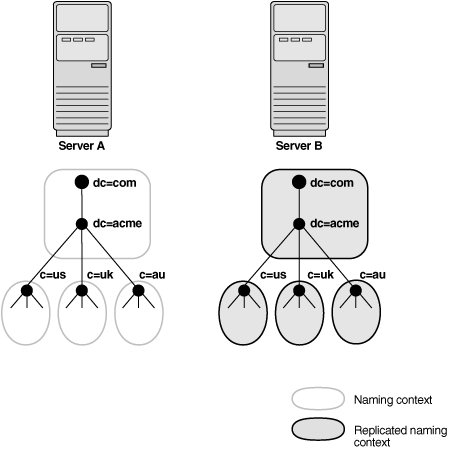In this post I would like to explain the concepts of Oracle Internet Directory 11g replication.
What is replication?
Replication is the process of copying the data from one environment to the other environments by maintaining the same naming contexts. In LDAP, the data is stored in DIT. A DIT can have multiple realms say
dc=uk,dc=acme,dc=com
dc=us,dc=acme,dc=com
dc=au,dc=acme,dc=com

In the above diagram the source OID server (left hand side) has 3 realms in DIT. These 3 realms can be copied over to another OID server using replication.
Why do we need replication?
One will opt for replication for following reasons:
- System availability
- Load balancing
- Local availability
Content to be replicated:
Data in DIT can be replicated in full or partial modes. The above diagram shows full replication where copying few realms say dc=uk and dc=us is partial replication.
Full replication can be based on either LDAP or Oracle Database Advanced Replication.
Partial replication is most often LDAP based.
Replication Direction:
Replication can be performed in one-way, two-way or peer-peer directions.
One-way: One node is the supplier and the other as the consumer. The consumer is read-only.
Two-way: Both nodes are Supplier and Consumer. Therefore both nodes are read/write enabled. Changes made in Consumer node can be replicated to Supplier node.
Peer-peer: All the nodes in replication group are both Supplier and Consumer to all other nodes.
Transport Mechanism: OID supports two protocols for data replication LDAP and Oracle Database Advanced Replication. LDAP type replication is recommended. However if the environment has Oracle SSO product then choose Oracle Database Advanced Replication. Oracle SSO needs Database Replication.
LDAP replication can be configured as One-way, two-way and peer-peer types. However the Oracle Database Advanced Replication is used only for peer-peer direction.
Directory Replication Group (DRG): All the directory servers that are involved in replication for a naming context are called as Directory Replication Group. The relationship among directory servers in Directory Replication Group is identified by a different directory entry called Replication Agreement.
Peer-peer direction is usually referred as Multimaster replication.
So the type of DRGs are:
- Single Master: In a DRG only one node acts as supplier and other nodes acts as consumers. In general this type of replication is performed by using LDAP protocol. Data updates happen only to one node and clients can read the node only from consumers.
- MultiMaster: Each node acts as both supplier and consumer. Multimaster replication can either be using LDAP or Oracle Database transport mechanism. Full DIT is replicated on each node. Multi master replication is always peer-peer. Multi-master replication is the only mechanism supported by Oracle SSO.
- Fan-Out: One Supplier will replicate directly to a consumer. That consumer will in-turn replicates to other consumers. It uses LDAP transport mechanism. It supports both Full or Partial replications and one-way or two-way directions.
Finally the below table will provide both the supported replication types with various replication concepts:
| Concept |
LDAP-Based Replication |
Oracle Database Advanced Replication-Based Replication |
| Content replicated |
Full replica/Partial replica |
Full replica (usually) |
| Direction of replication |
Peer-to-peer/One-way/Two-way |
Peer-to-peer |
| DRG Type |
Multimaster replication/Single-master replication/Fan-out replication |
Multimaster replication/Single-master replication, by switching all masters in a multimaster configuration except one to read-only mode. |
Replication implementation details are coming soon.

